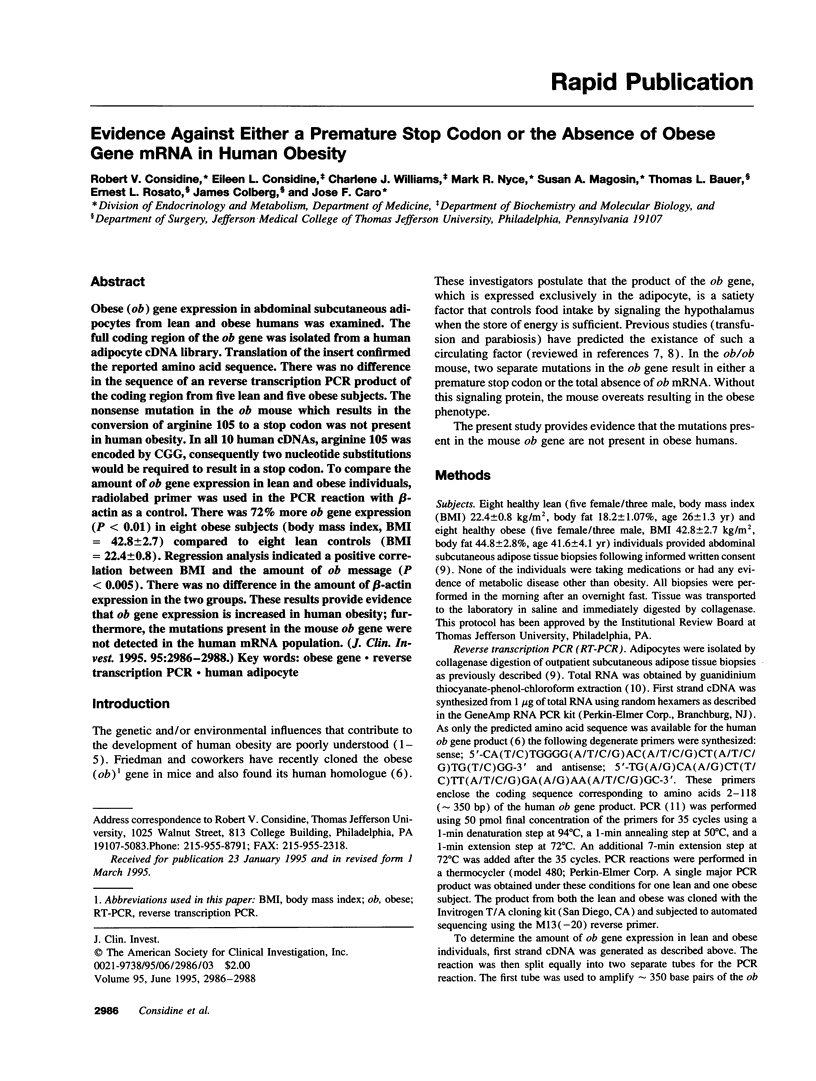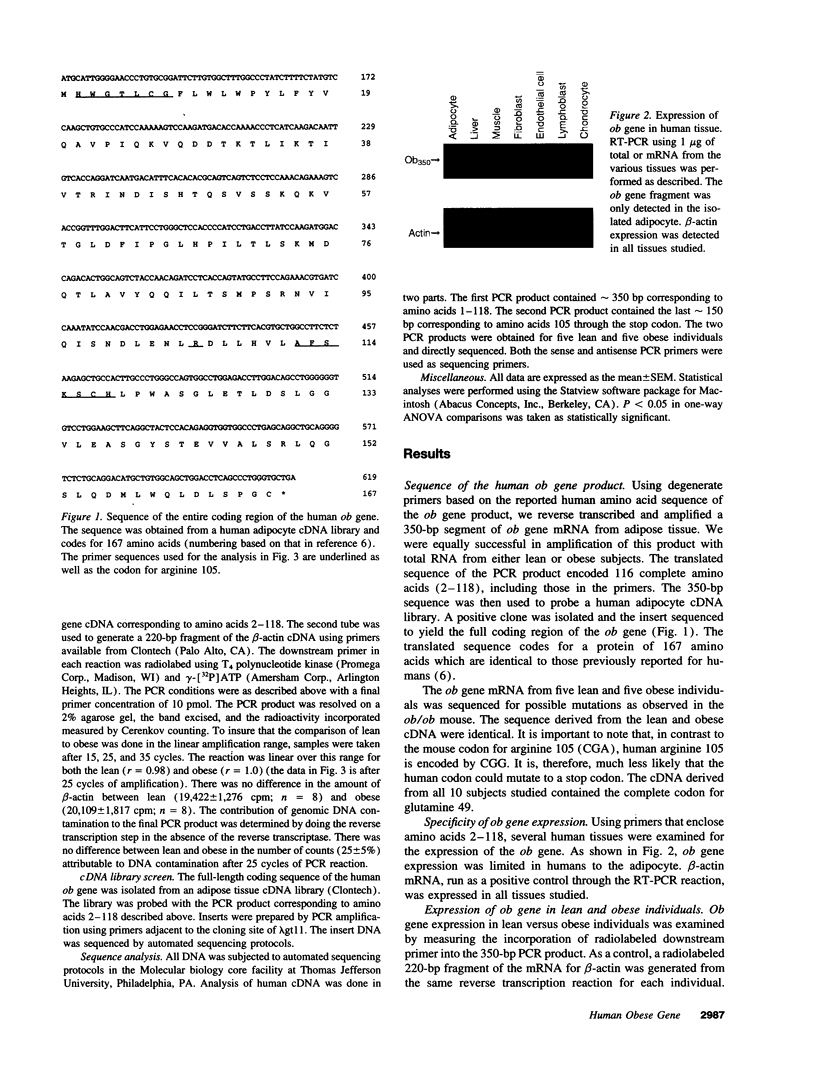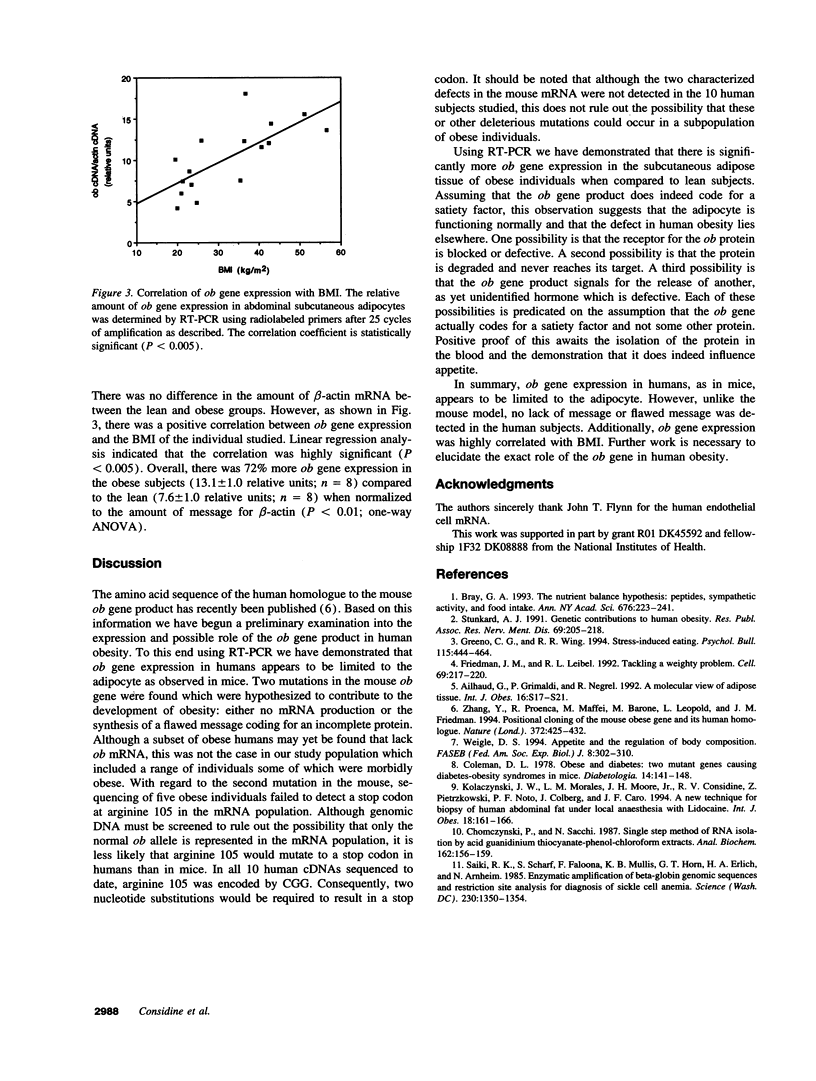Abstract
Obese (ob) gene expression in abdominal subcutaneous adipocytes from lean and obese humans was examined. The full coding region of the ob gene was isolated from a human adipocyte cDNA library. Translation of the insert confirmed the reported amino acid sequence. There was no difference in the sequence of an reverse transcription PCR product of the coding region from five lean and five obese subjects. The nonsense mutation in the ob mouse which results in the conversion of arginine 105 to a stop codon was not present in human obesity. In all 10 human cDNAs, arginine 105 was encoded by CGG, consequently two nucleotide substitutions would be required to result in a stop codon. To compare the amount of ob gene expression in lean and obese individuals, radiolabed primer was used in the PCR reaction with beta-actin as a control. There was 72% more ob gene expression (P < 0.01) in eight obese subjects (body mass index, BMI = 42.8 +/- 2.7) compared to eight lean controls (BMI = 22.4 +/- 0.8). Regression analysis indicated a positive correlation between BMI and the amount of ob message (P < 0.005). There was no difference in the amount of beta-actin expression in the two groups. These results provide evidence that ob gene expression is increased in human obesity; furthermore, the mutations present in the mouse ob gene were not detected in the human mRNA population.
Full text
PDF


Images in this article
Selected References
These references are in PubMed. This may not be the complete list of references from this article.
- Ailhaud G., Grimaldi P., Négrel R. A molecular view of adipose tissue. Int J Obes Relat Metab Disord. 1992 Dec;16 (Suppl 2):S17–S21. [PubMed] [Google Scholar]
- Bray G. A. The nutrient balance hypothesis: peptides, sympathetic activity, and food intake. Ann N Y Acad Sci. 1993 Mar 15;676:223–241. doi: 10.1111/j.1749-6632.1993.tb38737.x. [DOI] [PubMed] [Google Scholar]
- Chomczynski P., Sacchi N. Single-step method of RNA isolation by acid guanidinium thiocyanate-phenol-chloroform extraction. Anal Biochem. 1987 Apr;162(1):156–159. doi: 10.1006/abio.1987.9999. [DOI] [PubMed] [Google Scholar]
- Coleman D. L. Obese and diabetes: two mutant genes causing diabetes-obesity syndromes in mice. Diabetologia. 1978 Mar;14(3):141–148. doi: 10.1007/BF00429772. [DOI] [PubMed] [Google Scholar]
- Friedman J. M., Leibel R. L. Tackling a weighty problem. Cell. 1992 Apr 17;69(2):217–220. doi: 10.1016/0092-8674(92)90402-x. [DOI] [PubMed] [Google Scholar]
- Greeno C. G., Wing R. R. Stress-induced eating. Psychol Bull. 1994 May;115(3):444–464. doi: 10.1037/0033-2909.115.3.444. [DOI] [PubMed] [Google Scholar]
- Kolaczynski J. W., Morales L. M., Moore J. H., Jr, Considine R. V., Pietrzkowski Z., Noto P. F., Colberg J., Caro J. F. A new technique for biopsy of human abdominal fat under local anaesthesia with Lidocaine. Int J Obes Relat Metab Disord. 1994 Mar;18(3):161–166. [PubMed] [Google Scholar]
- Saiki R. K., Scharf S., Faloona F., Mullis K. B., Horn G. T., Erlich H. A., Arnheim N. Enzymatic amplification of beta-globin genomic sequences and restriction site analysis for diagnosis of sickle cell anemia. Science. 1985 Dec 20;230(4732):1350–1354. doi: 10.1126/science.2999980. [DOI] [PubMed] [Google Scholar]
- Stunkard A. J. Genetic contributions to human obesity. Res Publ Assoc Res Nerv Ment Dis. 1991;69:205–218. [PubMed] [Google Scholar]
- Weigle D. S. Appetite and the regulation of body composition. FASEB J. 1994 Mar 1;8(3):302–310. doi: 10.1096/fasebj.8.3.8143936. [DOI] [PubMed] [Google Scholar]
- Zhang Y., Proenca R., Maffei M., Barone M., Leopold L., Friedman J. M. Positional cloning of the mouse obese gene and its human homologue. Nature. 1994 Dec 1;372(6505):425–432. doi: 10.1038/372425a0. [DOI] [PubMed] [Google Scholar]



